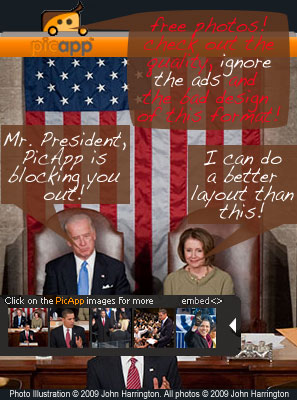Silly Rabbit - PicApp's Got Problems

PicApp, seen by some as a a solution to online revenue streams, just doesn't get it. Started by the same people that created PicScout (we wrote about PicScout here - Delusions of Grandeur, 5/27/09) - the model they're using of "free content that is ad supported" is a tried-and-true method of breaking into a crowded market. However, the next step is that once you have market share, then offering a "for a fee" version that does not have ads, and PicApp just seems to fail on several levels even in the initial offerings (which they will no doubt defend, since they are stating PicApp is still in "beta").
PicApp makes money off the photos by inserting ads into the image area. PicApp hold their application out as a legal way to post free photos from sources like Getty Images, Corbis, and Splash News, on personal blogs (Currently, you can't include your own images into PicApp to monetize them). Other images in thumbnail format are also overlaid on top of the main image, sometimes with problematic results (like the illustration above). They see hope to be able to then intersperse, overlay, or insert various ads into the window onto your blog where you can view the photo, and in turn, they earn a profit from those ads, presumably for more than it costs them for the license to show the image(s), with (or without) a split with the copyright owners. On the PicApp faq, one of the questions is "Can I take out the advertisement? " and the answer is "No. Please keep in mind, the advertisements are inserted so that we can continue providing you with such high-end, up-to-the-minute content."
The PicApp Terms & Conditions (here - terms and conditions), as Andy Beard (here) points out "that it is impossible to use these images and still syndicate your content within those terms and conditions", and further, it's a Javascript application, which means that it doesn't make it into RSS feeds.
A year ago, Getty alledgedly granted a blanket use of all the images in their library for PicApp's use, however this was supposed to be restricted to images that Getty "wholly owned", and not those of Getty contributors, where Getty would have to pay the contributors. Yet, that wasn't the case, and Getty images' non-wholly-owned images were making it into the PicApp application.
Inquiries with sources familiar with the PicApp dealings suggest that perhaps they don't have the deals they say they do. For example, The PicApp service is supposedly to be used only on "personal blogs" so they are not allowed to use the PicApp capabillities on big media company websites or blogs, like MSNBC or CNN, because - surprise surprise, that would encroach on Getty/Corbis/etc deals where they are making money, and where PicApp would be a sort of iStockphoto canibalization of those revenue streams if they allowed PicApp onto those platforms.
Is, for example, this use on the "Chicago Now" website (here) a personal blog? Not hardly, since there are ads on it - yet on the PicApp faq, it says "Will the PicApp image work on a site with Google AdSense?" the answer is "Absolutely! The two are unrelated." Yet, there is a difference between "will it work" and "am I allowed to do it". One of the other faq questions is "Can I make money with PicApp?" and the answer is am ambiguous "Coming soon, so stay tuned! " However, a blog with ads, whether from Google AdSense, or any other money-making features, would likely be precluded from using PicApp, because it's not a personal blog. Both the Chicago Now blog, The Fox Atlanta channel (here), and MVN NBA Fantasy Sites (as shown here) illustrate just how horrible the PicApp thumbnails overlays are, interferring with the image content.
On PicApps' own blog (here) one commenter writes "Can you guys have a smaller Google text link ad as opposed to the big honking ugly one?" Another blogger writes (here) "I was kinda shocked to see that it embedded an adsense ad right below the pic! I guess I wouldn’t have minded this – had I known in advance. But I hate things that are done “sneakily”, if you know what I mean. I can’t find any mention of the adsense ad anywhere on the PicApp site, and the plugin certainly does NOT say “ad supported”." Once these concerns were raised by the blogger, he suggested that the PicApp previews which were misleading, would be more clear in the future, and supposedly an "opt out" of the money-making side of things, but I've not seen that, to date. Further, with Google shutting down their Video AdSense program a few months ago (because of integration and disappointing results), so too is AdSense delivering lackluster results as webmasters are grumbling about revenues being down. More than one site has reported similar to this - Google cost per click declines (here) with a 13% decrease.
PicApp is poorly designed, with questionable licensing explanations vis-a-vis personal-versus-commercial blogs and sites, and is relying on AdSense to support this "free" application. Where is PicApp getting the money for such a large "blanket" agreement with Getty/Corbis/et al?
PicApp's sister company PicScout generates revenues from two sources - spidering the web looking for infringements and delivering to you those results, called Image Tracker. From their faq "How much does the Image Tracker service cost?", where they answer "Our pricing model is based on a number of different metrics. If you're goal is to monetize the images found (either by licensing or unauthorized use claims), we charge based on a percentage of the recovered revenues. If your objective is only for analytics, we charge based on each qualified match. We also charge a minimum fee in case the other revenue targets are not met. Most of the time, our prices are determined once we understand your business needs and the mutual opportunity. If you have more than 30,000 images and are interested in talking about what we can do for you, please contact us."
So, Getty/Corbis/et al fall into that 30k+ category as far as image count is concerned, but what about the percentage of recovered revenues? This is the second source of income for PicScout, with sources putting the percentage as high as 60% in some cases. So, if your image gets infringed, PicScout will pursue the claim and collect, say $10,000,and keep as much as $6,000. Clearly, Getty/et al don't need that aspect of the service, but they do have image assets that could be made available to populate PicApp. Could it be that PicScout gets to tout that they have Getty and Corbis as a client (thus enticing others by this endorsement by Getty/Corbis), Getty and Corbis get free tracking of uses and possible infringements, and PicApp gets access to all the images to populate and start up the service with AdSense revenues being split with the agencies? If this is the case, it's certainly appears very incestuous. Getty can ill afford the offspring of such a union gone bad.
Please post your comments by clicking the link below. If you've got questions, please pose them in our Photo Business Forum Flickr Group Discussion Threads.



